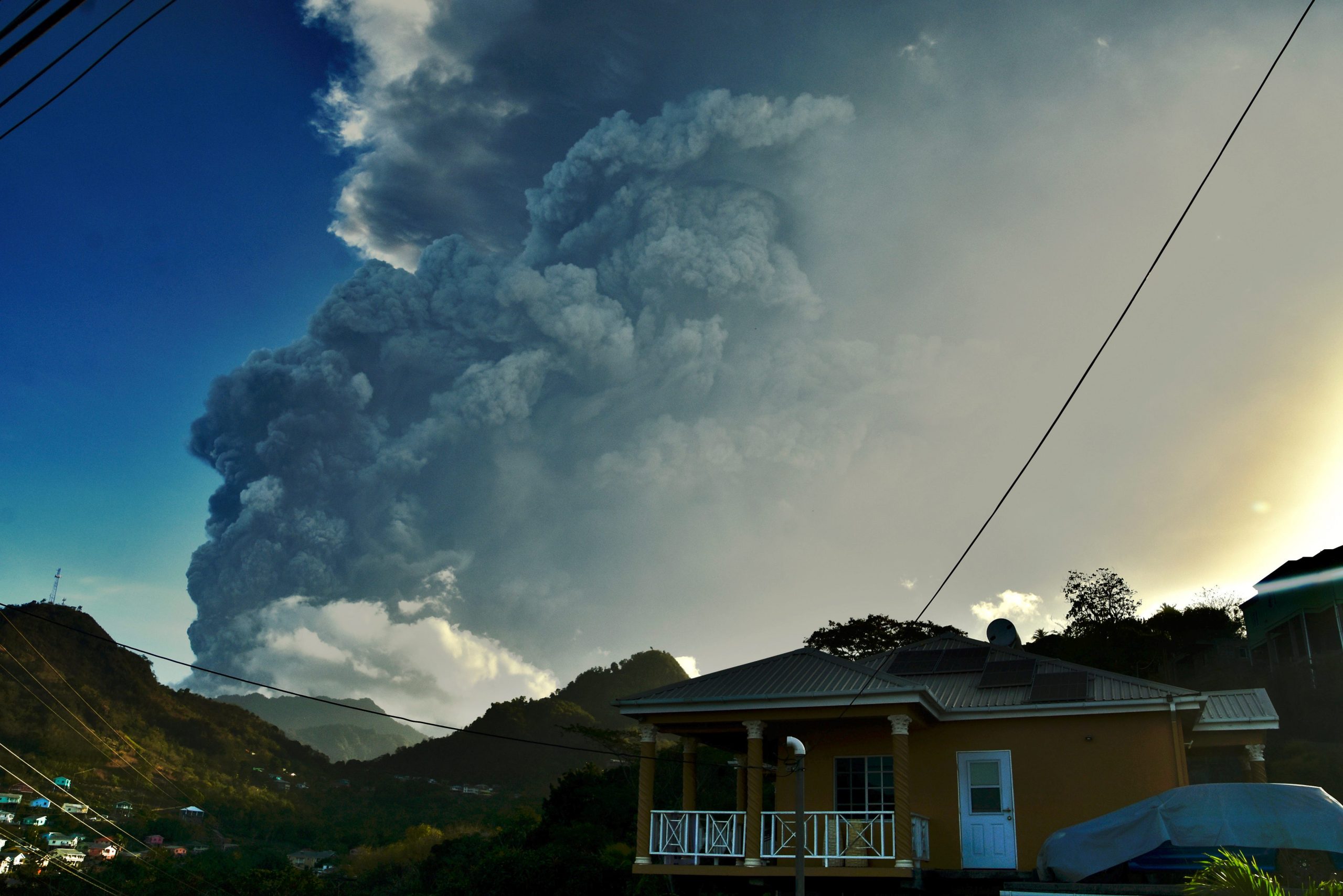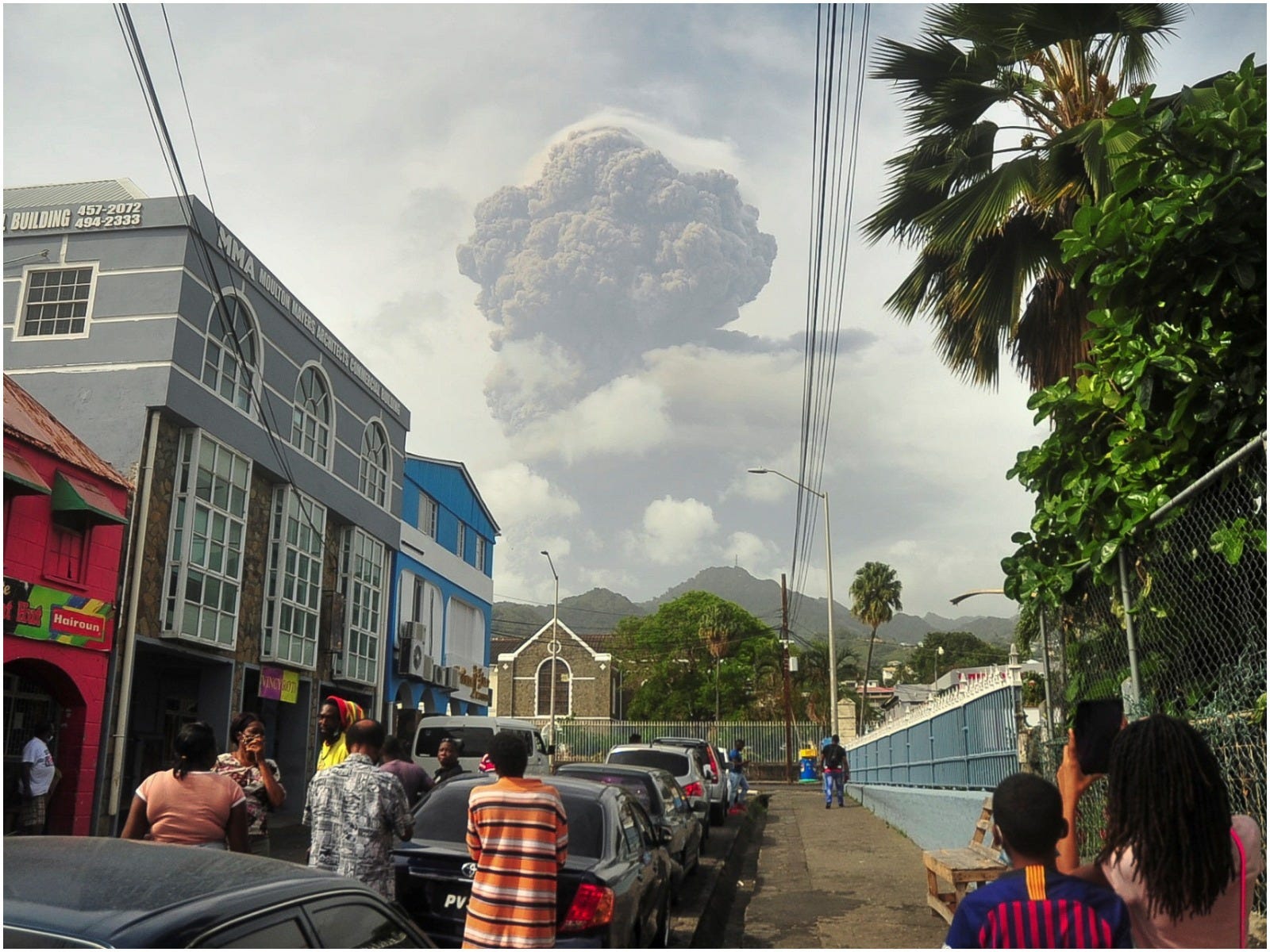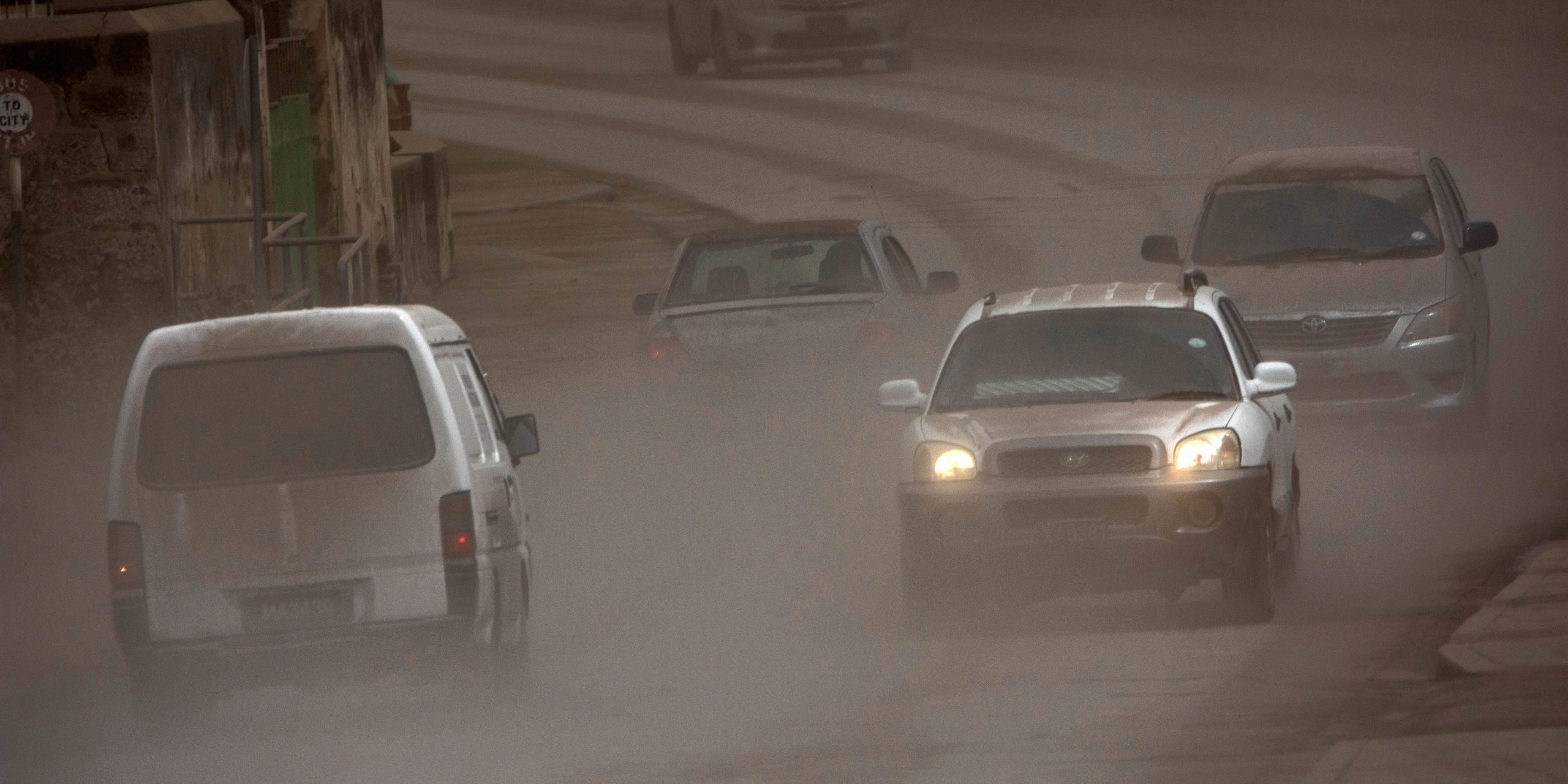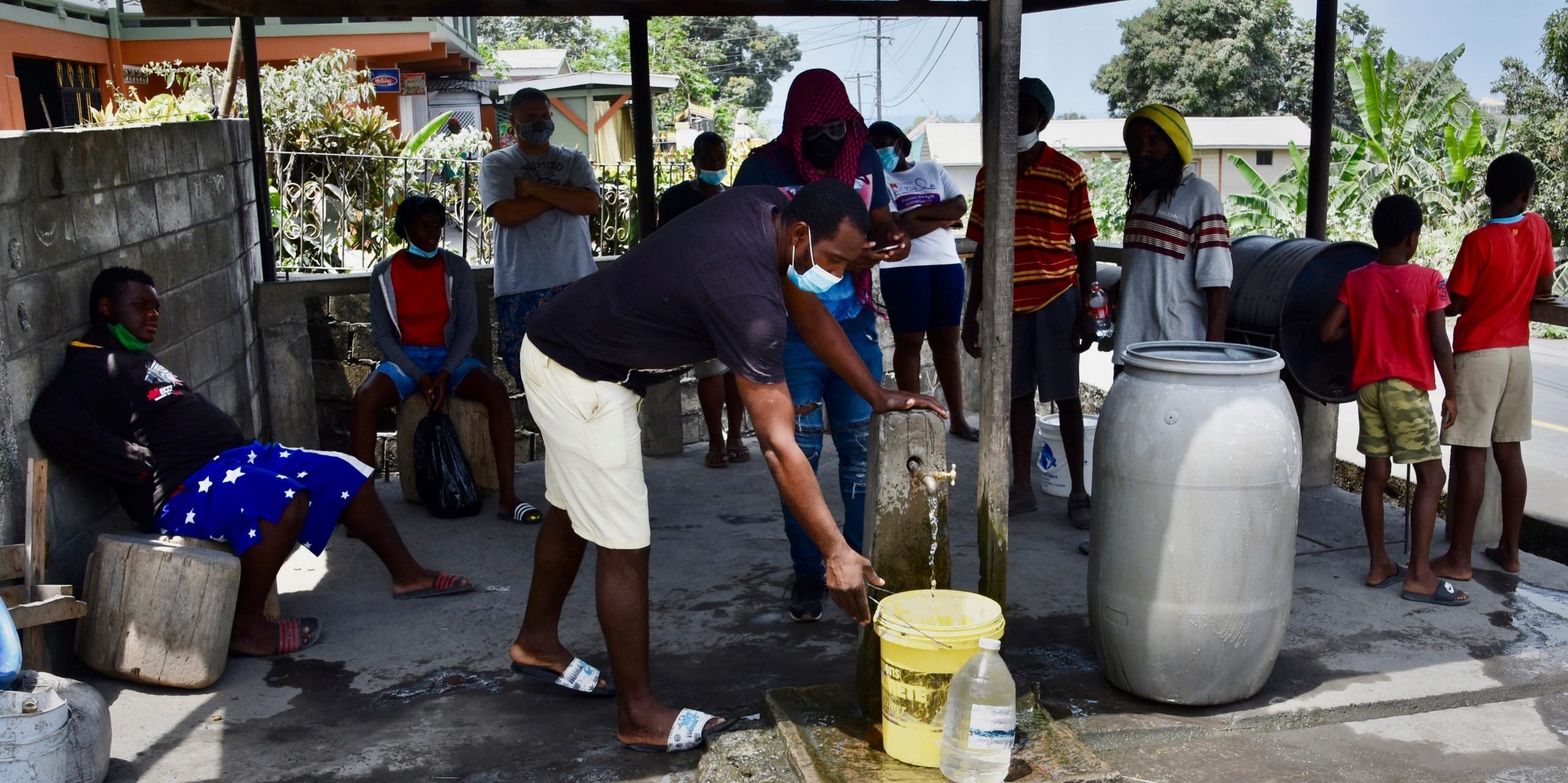
AP Photo/Orvil Samuel
- Saint Vincent is covered in ash as a volcano continues to erupt following Friday's initial blow.
- La Soufrière had been dormant for more than 40 years, but showed signs of activity in December.
- Residents of the island have sprung to action providing outreach and aid to those displaced.
- Visit Insider's homepage for more stories.
Rachel Jayne already had a household full of people by the time the volcano began rumbling Thursday night.
As Saint Vincent and the Grenadine's long-dormant volcano, La Soufrière, roared to life last week, Jayne's friends were among the thousands evacuated from the "red zone" on the main island's Northern tip.
Jayne and her guests congregated in her family's home in the South, far from the volcano in the nation's "green zone." They heard La Soufrière's rumblings throughout the evening, Jayne told Insider, but continued calmly with preparation efforts, gathering water and storing food.
Then, on the morning of Friday, April 9, Jayne said they heard a "massive bang."
"It sounded like thunder," she told Insider. "Ten minutes later we looked up and … it looked like God was coming. It looked like the skies had opened."
But it wasn't until the second eruption, later Friday morning, that Jayne said she realized "it was serious."
"Friday night, that's when it started to look like it was snowing," she said. "It looked like a Christmas card."
Five days after the first eruption, the country remains on high alert as Saint Vincentians face uninhabitable conditions wrought by the seismic disaster, as well as ongoing uncertainty amid the unpredictable volcano's continued eruptive activity.

Reuters
La Soufrière started showing warning signs in December 2020 that an eruption was imminent
La Soufrière's history casts a deadly shadow on the island after an eruption in 1902 killed nearly 1,700 people, The New York Times reported. But before last week, Saint Vincent hadn't seen a volcano eruption since 1979.
The long-dormant volcano began showing signs of revival again this past December.
About four weeks ago, Jayne said Vincentians started to hear from the country's seismic team that a big eruption was on the horizon. Then, on Thursday night, the government ordered roughly 16,000 people in the surrounding area to evacuate from the North, the Associated Press reported.
The volcano remained active throughout the weekend, exploding again early Monday morning in the largest eruption yet, which sent pyroclastic flows down the mountain. The island woke to yet another eruption Tuesday morning.
There have been no immediate reports of injuries or deaths since the volcano first blew Friday morning, but officials are scrambling to respond to the most recent eruptions, worried about the unknown number of people who chose to remain behind in the red zone, the AP reported.
'Everybody woke up to just ash, everything covered in ash'
Arena Foy, a 23-year-old entrepreneur and influencer in Saint Vincent, told Insider the last few days have been "really hard," and that she feels lucky to be living in a safe part of the island.
Foy said Vincentian children learn about La Soufrière at a young age in primary school, but nothing could have prepared her for living through a real eruption.
"I thought I was somewhat prepared mentally, but as the days go by, I realize ... this is actually really serious," she said. "Never did I think in a million years I would witness or live through a volcanic eruption."
After the first eruption Friday, Foy said she saw a "huge cloud of smoke" in the air before the sky turned black.
"We didn't start to see the effects of the ash until the second day," Foy said. "So everybody woke up to just ash, everything covered in ash."
-Lavern King 🇻🇨 (@Lavern_King) April 10, 2021
La Soufrière's ash and debris have traveled far beyond Saint Vincent
Roughly 120 miles due west of Saint Vincent and the Grenadines, energy and climate specialist Gerald Lindo woke up Saturday morning to his home in Barbados completely shrouded by ash and dust.
Thanks to favorable winds, the first eruption on Friday produced only a "white haze" in the Barbados sky, Lindo told Insider. But then the winds changed "quite dramatically."
"You could barely see the sun," Lindo said of his home in South Barbados. "The North had it much much worse. It basically blocked out the sun at several points during the weekend."

AP Photo/Chris Brandis
Lindo said La Soufrière's dome collapsed Monday, a positive sign that indicates any continued eruptions will likely be effusive eruptions, with magma rising to the surface and flowing out of the volcano, as opposed to the destructive, explosive eruptions of the past few days.
But nobody knows for sure when the volcano could return to dormancy.
"It's definitely a waiting game," Lindo said. "It's not up to us. It's up to the volcano."
The eruption has exacerbated the struggles of a country already dealing with the coronavirus pandemic
COVID-19 has complicated the already-challenging response to the natural disaster.
Cruise ships have been dispatched to the island to evacuate people to neighboring islands, but only those who are vaccinated can board, the prime minister announced over the weekend.
"We were so focused on the pandemic and being safe with the coronavirus situation that I think we just overlooked the whole volcanic eruption," Foy said.
The ongoing eruptions have triggered power cuts and water outages across the island and Foy said she only has access to water for about 30 minutes each day.
-Ash in my hair.. 🇻🇨🌋🙏🏽 (@Rachie784) April 12, 2021
"There's no power, there's no water, and we're trying to clean and clean as much as we can so the ash doesn't keep blowing and circulate around," Jayne said.

AP Photo/Orvil Samuel
Meanwhile, with the North almost completely uninhabitable, shelters have popped up in the South for the thousands of evacuees, many of whom left with only their passport, Jayne said.
"In the north of our country, that's where the poorest of the poor live," Jayne said. "What are they bringing if they already had nothing?"
The ash in the air poses additional breathing problems for the elderly and asthmatic amid a respiratory pandemic, and Jayne said she worries about multiple families congregating together in shelters in the face of COVID-19's easy transmission.
Foy and Jayne both said they've been blown away by the country's response to help those in need
"As soon as this happened, I knew I had to do something," said Jayne, who is trained in community work.
She runs an online store that sells Caribbean foodstuffs and said she immediately opened her social media up for donations. The response, she said, has been phenomenal.
Foy, too, has used her social media platform to post important updates about the volcano, shelters, and humanitarian efforts around the island.
She and her friends also started a GoFundMe to buy food and supplies from supermarkets for those displaced or in shelters.
"No airplanes, no ships can come in because of all the ash," she said. "So we can only depend on supplies that are in the country right now."
Foy spent most of Monday buying diapers, toilet paper, and food in bulk to donate to those in need.
"I must say, Vincentians have really stepped up to volunteer and help multiple people," she said.
"Everyone around us has literally opened up their homes ... the community spirit here is great," Jayne said. "There are people on the road sweeping ash in the day, and making pizza to take to people in shelters."
"It's just been phenomenal. I've never seen a whole country come together and work to get through something like this."